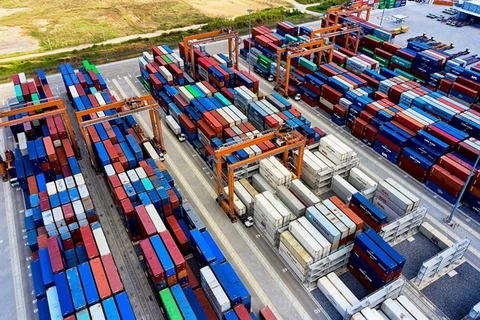Hanoi (VNA) - Emphasising the maritime sector’s need to dominate the market share of import and export freight transport, Minister Nguyen Van Thang has urged the Vietnam Maritime Administration to develop solutions for this issue, as it is essential for the national interest.
During a conference held to review the first half of the year and outline key objectives for the remaining six months of 2023, Minister Thang highlighted numerous challenges faced by the maritime sector.
He emphasised that the industry’s institutional and developmental mechanisms have not kept pace with reality.
The Vietnamese fleet size and capacity in the transportation market remains limited, seaport infrastructure investments are fragmented, and the connectivity of transportation infrastructure to seaports is unsynchronised. Additionally, there is a shortage of skilled maritime personnel.
In light of these challenges, Thang stressed the need to prioritise the improvement of the freight transport market share, particularly in international freight transport.
Currently, 90% of import and export goods rely on foreign shipping lines, he noted.
To address these concerns, the Minister urged concerted efforts to enhance seaport development and optimise the Vietnamese fleet’s capabilities.
By doing so, the maritime sector will be able to assert itself in the market, reducing dependency on foreign shipping lines and safeguarding the nation’s economic interests.
 Minister Nguyen Van Thang speaks at the conference to review the performance of the Vietnam Maritime Administration in the first six months of 2023 and implement key tasks in the remaining months of the year (Photo: Vietnam+)
Minister Nguyen Van Thang speaks at the conference to review the performance of the Vietnam Maritime Administration in the first six months of 2023 and implement key tasks in the remaining months of the year (Photo: Vietnam+) Regarding the investment and maintenance of maritime infrastructure, Thang has instructed relevant agencies and units to ensure timely completion of maritime infrastructure projects and adherence to the planned disbursement of public investments.
He urged the search for the allocation of medium-term capital resources for the 2026-2030 period, focusing on enhancing transport infrastructure connectivity to major seaports such as Lach Huyen, Nghi Son, Lien Chieu, Quy Nhon, and Cai Mep-Thi Vai.
During the conference, Hoang Hong Giang, Deputy Director of the Vietnam Maritime Administration, highlighted the impact of economic recessions, high fuel prices, and inflation, which have led to a significant decrease in shipping demand in key consumer markets.
In the first half of 2023, Vietnam’s seaports witnessed a 2% decrease in the total volume of goods, amounting to 362.7 million tons, compared to the same period in 2022.
The number of ships passing through the seaports also dropped by 7% to 48,700 vessels compared to the previous year.
While acknowledging that Vietnam’s logistics costs accounted for approximately 16.8% of GDP in 2022, Giang conceded that the figure remains relatively high compared to the global average of around 10.6%.
Nevertheless, positive changes have been observed in recent years, bringing Vietnam’s logistics costs closer to those of neighboring countries in the region. In 2018, logistics costs accounted for approximately 21% of GDP.
Vietnam’s logistics industry is estimated at around 60-70 billion USD annually, with transportation activities alone making up 60% of this figure (equivalent to approximately 35-40 billion USD per year).
“Therefore, reducing transport costs plays a crucial role in lowering logistics costs, enhancing Vietnam’s export competitiveness, and improving the overall export environment,” he said./.
























